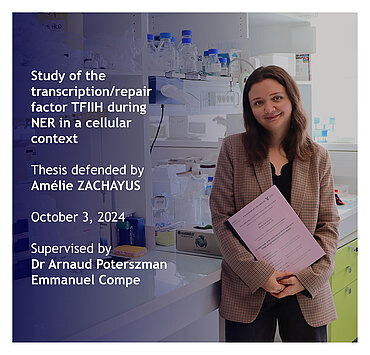Congratulations to Amélie ZACHAYUS on the acceptance of her thesis!
her work led by Dr Arnaud Poterszman and Dr Emmanuel Compe
is entitled: "Study of the transcription/repair factor TFIIH during NER in a cellular context."

Summary of her research work:
Xeroderma Pigmentosum (XP), whether associated with Cockayne syndrome (XP/CS) or not, and Trichothiodystrophy (TTD) are three rare genetic disorders characterized by severe photosensitivity. These diseases are all linked to mutations in nucleotide excision repair (NER) factors, particularly the transcription/repair factor TFIIH, leading to defective repair of UV-induced DNA damage. While significant progress has been made in understanding TFIIH functions under normal and pathological conditions over the last decade, this progress has been constrained by the lack of models to study the complex in a cellular context.
To address this limitation, her thesis focused on developing innovative cellular models. These models allowed GFP tagging of key TFIIH subunits (XPB, XPD, and MAT1) and the introduction of patient-specific mutations commonly observed in XP/CS and TTD.
Using a multiphoton laser, she induced UV-like DNA damage and measured the accumulation of XPD, XPB, and MAT1 at the damage sites. Her results revealed that core-TFIIH and CAK exhibit distinct recruitment and release kinetics. Additionally, her findings showed that mutations directly or indirectly impairing XPD helicase activity reduce TFIIH accumulation at lesions and hinder its release. Inhibition of CDK7 kinase activity using THZ1 significantly decreased TFIIH recruitment at damage sites, suggesting an involvement of CAK in the NER process. Lastly, she demonstrated that in the absence of XPA and XPG, CAK accumulates more at damage sites.
Overall, her thesis work sheds light on the dynamics of NER and TFIIH in both normal and pathological conditions, providing deeper insights into NER dysfunction in XP, XP/CS, and TTD patients.
Skills acquired at IGBMC
Autonomy, rigor, and perseverance.
Life at IGBMC
At IGBMC, she benefited from the presence of numerous cutting-edge platforms and highly skilled individuals. This supportive environment was instrumental in helping her achieve her research goals.
Collaborations
Her work involved collaborations with:
• The Muséum d'Histoire Naturelle de Paris (MNHN)
• Dr. Caroline Kisker’s team at the University of Würzburg
Funding and partners
Her thesis was funded by an ANR grant for the first three years, followed by a fellowship from the FRM (Fondation pour la Recherche Médicale) in her fourth year.
Future projects
She will remain at IGBMC until the end of the year before pursuing her career abroad to continue her research journey.
